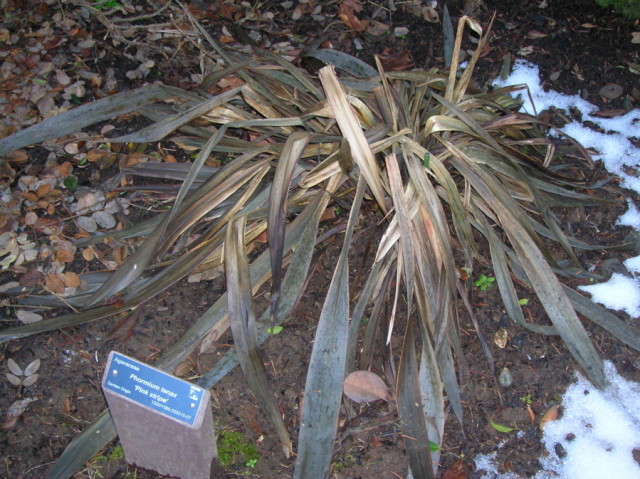Right on Schedule, Winter Weather’s Here

The next few days of frost are not expected to be as severe as the ones we experienced in the past two winters… but… you never know! (This is what a Phormium tenax ‘Pink Stripe’ looked like up at the Hoyt Arboretum in February 2009, after the freeze – don’t let it happen to your plants this week!)
It is not common for sub-freezing temperatures to hit the Portland Metro area quite so early in the season. Here are some things you can do to help ease any newly-planted or tender plants through this possibly rocky entry into winter:
MULCH
If you have planted new plants in the last month or two, spread some garden mulch – ground up bark or wood chips, well-rotted compost or pine needs, thick clumps of conifer boughs or leaves if necessary – over the crowns of young plants. Just remember to pull the mulch away when the weather warms up – heavy mulch can smother plants during our wet, mostly mild winters.
It would be helpful also to spread a couple of inches of mulch on flowering maples (Abutilon ), hardy fuchsias, semi-tender salvias, New Zealand flax (Phormium ), and other half-hardy plants.
PROTECT CONTAINER PLANTS
If you have plants in containers, either pull them under a protected eve or porch close to the house and make sure they’re well watered or – if they are tender below 25F – bring them indoors for the next few nights when temperatures are predicted to stay in the low 20s. If the pots are too large to move, wrap them snugly in a blanket of heavy duty frost cloth. Most common citrus (Meyers lemons, blood oranges, etc) should come inside, if they aren’t inside already. They can go back out when temperatures rise again.
Personal experience over the years has taught me that, with container plants, if they can be picked up easily, it’s always best to bring them inside when in doubt. The worst that can happen is that some slugs crawl out of the pots and onto your living room furniture. Big deal. You can put the plants back out before Thanksgiving, your living room will be pretty again and those pots on your front porch will look fantastic, as if the cold weather never happened. The alternative is to leave them out and possibly watch them slowly turn brown and mushy over the next few weeks.
Aspect matters, though: if you live in Sellwood (Portland’s "banana belt") and your porch faces south and is protected under an eave and there’s plenty of wind protection and radiant building heat, your plants will fare better than if they are on a wind-swept, north- or east-facing bare hillside in Gresham. (Yep, I know, that probably goes without saying.)
WRAP
A final thought. If you have some plants that have suffered over the past two winters, you might consider wrapping the tops in heavy duty frost cloth. I like to use wooden clothes pegs to hold the fabric in place: it’s easy on, easy off and I store them with my frost cloth so the whole process is easy. Merely swaddling plants in frost cloth usually won’t keep plants alive that are simply not cold-hardy enough to survive the low temperatures but it can help preserve the flower buds. (I am wrapping the top of my Edgeworthia, which lost all its flower buds the past two years, thanks to being placed where the morning sun hits it on cold winter mornings.) Wrapping can also help protect the foliage from damage. So you could say it’s sometimes cosmetic. But still worth it, as far as I’m concerned.
And since I smartly consolidated most of my potted plants last week, it will be pretty easy to just swathe the whole shebang in sheets of white frost cloth, Christo-style.
